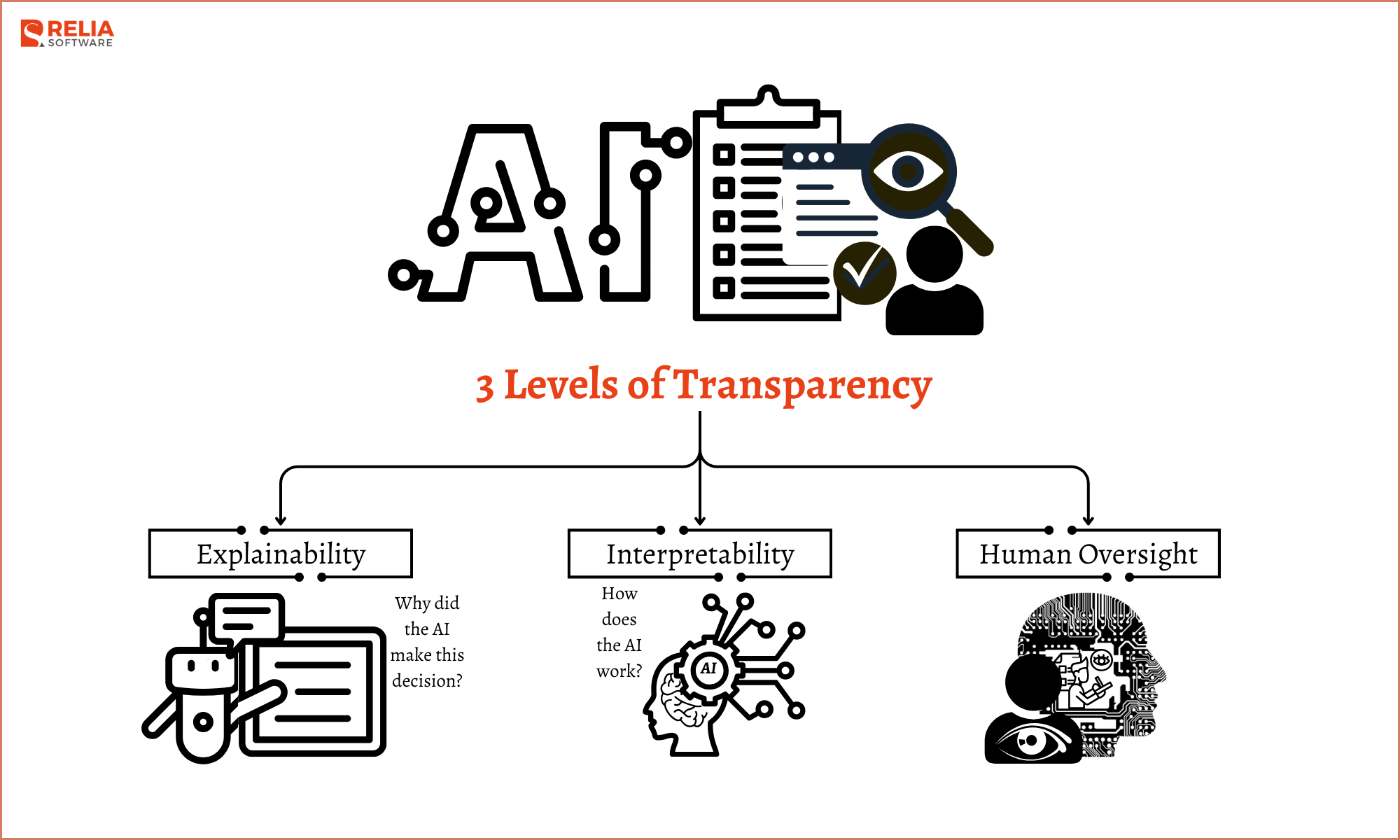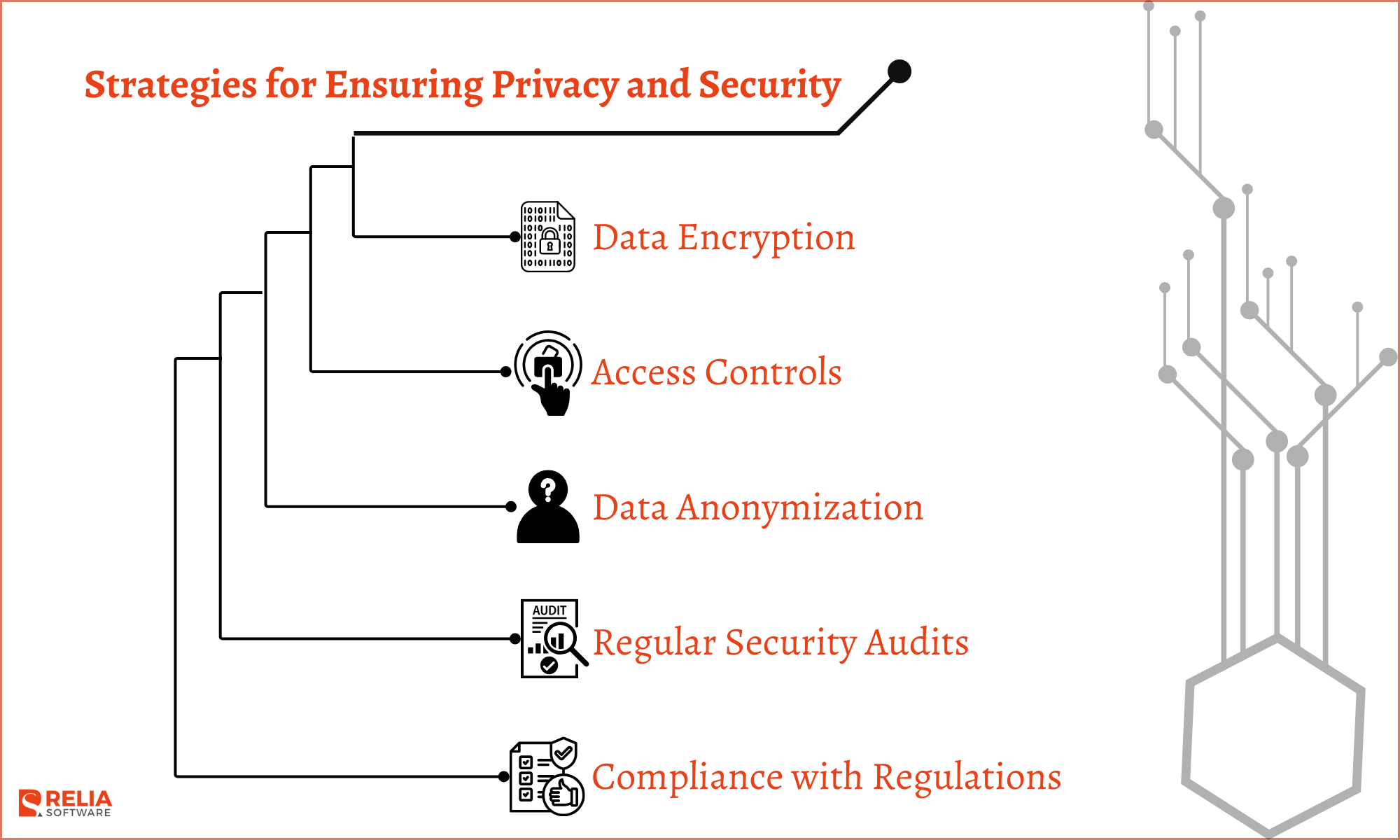Artificial intelligence (AI) is quickly changing our world. It is affecting everything from what people post on social media to how doctors diagnose illnesses. AI has great potential but needs responsible development.
Being denied a loan owing to biased AI decisions—how do you feel? Annoying, right? We must follow key principles to ensure AI benefits everyone fairly and safely. This guide explores four key principles of Responsible AI: fairness, transparency, accountability, and security & privacy.
>> Read more:
- Will AI Replace Software Engineers Altogether?
- What is the Responsibility of Developers using Generative AI?
- Which Case Would Benefit from Explainable AI Principles?
What is Responsible AI?
Responsible AI means AI systems are built and used in an ethical and responsible way. It makes sure that AI technologies are made and used in ways that are fair, clear, responsible, safe and private. This approach prioritizes the well-being of humans and society, thereby preventing damage and fostering confidence in AI applications.
Principle 1: Fairness
Fairness in AI means making sure AI systems make decisions that are unbiased and fair. It’s not about making all outcomes perfectly equal but about avoiding discrimination against certain groups based on race, gender, or socioeconomic status.
2 Popular Types of Bias
AI systems can become biased in two key ways:
- Data Bias: When the training data used to build the AI model is biased.
- Algorithmic Bias: When the design of the AI algorithm itself introduces bias.
Examples of Bias
Data Bias:
- Loan Approval System: A bank uses AI to decide loan approvals based on historical data. If the data reveal increased loan defaults in a given area, an AI system may unfairly reject applications from residents of that area even with good credit.
- Medical Diagnosis Tool: An AI tool for diagnosing illnesses is trained on medical data primarily from wealthy, urban areas. This can lead to misdiagnosis for patients from rural areas or those with lower incomes, whose health profiles might differ significantly.
- Image Recognition Software: An AI trained largely on photographs of light-skinned people may struggle to distinguish darker-skinned faces, resulting in biased or incorrect results.
Algorithmic Bias:
- Content Filtering System: An AI filter designed to remove offensive content from social media platforms might be programmed to flag slang terms more commonly used by certain demographics, unfairly censoring their speech.
- News Recommendation Engine: An AI that suggests news articles might choose shocking headlines over correct, in-depth reporting, causing false information.
- Self-Driving Car Algorithm: A self-driving car's decision-making might prioritize the car's safety over that of pedestrians or cyclists, which could lead to unfair and possibly dangerous choices.

Strategies for Mitigating Bias
Fortunately, there are steps to take towards fairer AI:
- Train AI models on data that have to reflect the real world's diversity.
- Regularly evaluate AI systems for bias through metrics.
- Always maintain human oversight.
- Apply techniques like debiasing algorithms and fairness-aware model design to reduce bias.
Fairness in AI is a constant challenge. Researchers constantly create new bias-detection methods. We can keep AI useful for everyone by recognizing bias, its risks, and how to mitigate them.
Principle 2: Transparency
Transparency means making it clear how AI systems work and make decisions. It shows how AI models function, what data they use, and how decisions are reached so users can trust and verify the results.
When people understand how AI decisions are made, they are more likely to trust and accept those decisions. Transparency also makes it easier to spot and fix mistakes or biases, leading to fairer outcomes.
Different Levels of Transparency
Explainability: Users can understand AI decisions via explainability. It addresses "Why did the AI choose this outcome?" Explainability can be improved by:
- Highlighting decision-influencing data.
- Showing how small input data changes can affect results.
- Showing similar AI decisions makes patterns easier to follow.
Interpretability: This goes beyond explaining individual decisions and aims to make the entire AI model more understandable. It focuses on the question: "How does the AI work?". Here's how interpretability can be achieved:
- Simpler Models: Use straightforward algorithms that are easier to explain, though they may not be as powerful as complex ones.
- Visualization: Tools like decision trees or rule sets can visually represent the AI’s decision-making logic.
Human Oversight: Human oversight involves including people in the AI decision-making process. This ensures accountability even when the AI’s workings are complex. Here's how human oversight works:
- Humans review and approve the AI's recommendations before they are implemented.
- Developers provide tools to help reviewers understand the AI’s decisions.

Examples of Transparency
- Loan Approval Systems: Clearly state the reasons a loan was accepted or declined, such as credit score or income, so applicants may better understand the outcome.
- Facial Recognition Software: Inform users about the system’s accuracy, potential errors, and let them choose not to be included.
- Content Moderation AI: Share the criteria used to flag content and offer an appeals process for flagged content.
Strategies for Achieving Transparency
- Build Understandable AI Models: Use techniques like decision trees or rule-based models to make it easier for people to understand than complex neural networks.
- Regular Audits: Check AI systems regularly to ensure they work as expected and to spot any hidden biases or errors.
- Clear User Interfaces: Design simple, clear interfaces that explain AI decisions so users can understand and trust the system.
Researchers are constantly developing new techniques for explainable AI (XAI). Transparency in AI will keep getting better as these tools get better. Thus, we can make AI systems that are not only useful, but also reliable and responsible.
Principle 3: Accountability
Accountability in AI means that AI developers and organizations are accountable for their AI systems' behavior and impact. This principle defines roles and duties for managing AI systems and solving issues. It simply answers the question "Who is responsible when something goes wrong?"
Examples of Accountability
- Financial Fraud Detection System: An AI used by banks to detect fraud may misclassify legal transactions as suspicious. As a result, developers may be liable for AI model failures, and banks review flagged transactions and provide customer assistance.
- Self-Driving Car Accidents: Multiple parties may be liable if an autonomous car makes a mistake and causes an accident. Manufacturers may be liable for software flaws, data providers for biased training data, and regulators for supervision failures.
Strategies for Ensuring Accountability
- Clear Documentation: Keep detailed records of how AI systems are designed, developed, and make decisions to identify and fix issues faster.
- Regular Audits: Audit AI systems to verify ethical compliance and correct biases and faults.
- Impact Assessments: Evaluate how AI systems affect different stakeholders to identify and reduce any negative impacts.
- User Feedback: Allow users to share feedback on AI systems, which can be used to improve their performance.
- Transparent Reporting: Share clear reports on how AI systems perform, including any problems found and how they were fixed.
Principle 4: Privacy and Security
Security and Privacy Concerns
Security:
- Data Breaches: Cyberattacks targeting AI systems can either steal or change important data.
- Adversarial Attacks: Hackers might manipulate AI models with malicious inputs to cause incorrect or harmful results.
- Algorithm Exploits: Attackers could exploit weaknesses in AI algorithms to manipulate their behavior or gain control.
Privacy:
- Data Collection: Large-scale data collecting for AI begs questions regarding user privacy and possible misuse.
- Data Inference: Even anonymized data can sometimes reveal sensitive information about individuals.
- Lack of Transparency: When users don’t know how their data is being used, they will concern about privacy and won't have control over their data.
Strategies for Ensuring Privacy and Security
- Data Encryption: Encrypt data during storage and transmission to keep it safe from unauthorized access. Even if breached, encrypted data is difficult to read or misuse.
- Access Controls: Limit who can access sensitive data with strong authentication methods like passwords, biometrics, or multi-factor authentication.
- Data Anonymization: Remove personally identifiable information (PII) from data before using it for AI training, ensuring privacy while still gaining insights.
- Regular Security Audits: Perform routine audits to identify and fix vulnerabilities in AI systems.
- Regulatory Compliance: Follow data protection laws like GDPR or CCPA by getting user permission, safeguarding their data, and so granting them rights to access, edit, or delete their information

Examples of Privacy and Security
- Healthcare Data Protection: AI tools studying medical information must encrypt and anonymize data to protect patient privacy. Maintaining trust and HIPAA compliance requires regular audits.
- Financial Transactions Security: Banks using AI for fraud detection must securely encrypt transaction data and limit access. They should also comply with regulations like PCI DSS to ensure security and build customer confidence.
- Smart Home Devices: AI-powered smart home gadgets like voice assistants must secure user data. Encrypt voice recordings and restrict device control to authorized users.
>> Read more about AI:
- Benefits of Artificial Intelligence (AI) in Mobile App Development
- AI in Software Testing: How It Works, Benefits & Challenges
- Top 12 Best Free AI Chatbots for Businesses
- Top 5 Best Generative AI Tools
- Top 17 Best AI Apps For Individuals and Businesses
- Top 9 Best Deep Learning Frameworks for Developers
- Top 7 Machine Learning Solutions For Growing Your Business
Final Thoughts
Fairness, Transparency, Accountability, and Security & Privacy are the 4 key principles of Responsible AI that guide the development and use of AI systems. Following these principles helps make AI systems more ethical, trustworthy, and fair.
There are still problems, but progress has been made in explainable AI, regulations, and security. This gives us hope for a future with more responsible and trustworthy AI.
- development

